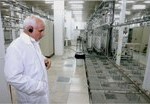 By Simon Henderson and Olli Heinonen
By Simon Henderson and Olli Heinonen
Although both Washington and Tehran deny reports that they have agreed to bilateral nuclear negotiations, the rumors will prompt fresh debate about what concessions the United States can or should make.
International diplomacy concerning Iran’s nuclear program centers on the regime’s lack of compliance with agreements it has signed to ensure that peaceful nuclear work is not used as a cover for weapons development. Tehran denies that it has any nuclear military intentions, but it continues to obstruct International Atomic Energy Agency (IAEA) efforts to confirm this. The challenge for diplomacy is to break this logjam — and quickly.
The main concern at the moment is Iran’s uranium enrichment efforts, which are conducted using centrifuge technology acquired from Pakistan in the 1980s. The fear is that without resolution of uncertainties about Tehran’s intentions, the regime will be able to amass enough high-enriched uranium to make at least one nuclear bomb within a matter of months. This is known as breakout. Unfortunately, much of the public debate about this potential scenario is hampered because Iran’s current enrichment level — which produces uranium with slightly less than 20 percent of the fissile isotope U-235 — sounds a long way from the 90 percent needed for a bomb. This is not the case. Israeli prime minister Binyamin Netanyahu tried to explain why in the drawing he displayed during his September UN address, but largely failed.
UNDERSTANDING ENRICHMENT
In fact, most of the work of producing weapons-grade material has already been done once 20 percent is reached. In natural uranium, the proportion of U-235 (the material needed in an atomic bomb) is just 0.7 percent, compared with the predominant U-238. In other words, in a thousand atoms of uranium, the ratio of U-235 to U-238 is 7:993. In 20 percent enriched uranium, the ratio is 7:28 — that is, as many as 965 U-238 atoms have been stripped from the gaseous uranium feedstock in the centrifuges. To obtain weapons-grade material of around 90 percent enrichment — a ratio of 7:1 — only another 27 U-238 atoms need to be removed.
The problem in allowing Iran to continue any enrichment work without a clear indication that it has given up suspected nuclear military ambitions is twofold. First, its competence with centrifuge technology will likely improve, and second, it will eventually develop improved centrifuges to replace its existing low-efficiency machines, allowing it to rapidly produce larger quantities of weapons-grade material. It is already experimenting with different centrifuge “cascades” and working on more advanced prototypes. Although success currently appears elusive, this barrier is unlikely to persist for long. Pakistan, the initial supplier of Iran’s low-grade centrifuges, has used a more efficient second-generation type since the 1980s, and North Korea, which supplies Iran’s medium-range, nuclear-capable missiles, has had operational advanced centrifuges for several years. Both countries overcame tight international controls on sensitive imports of material and technology to achieve these advances.
IRAN’S BREAKOUT TIMETABLE
Iran already has some 240 kilograms of 20 percent enriched uranium — an amount that, if further enriched, could produce the 27 kilograms of 90 percent enriched uranium needed for a simple atomic bomb (in IAEA jargon, a “significant quantity”). More advanced weapon designs would require even less uranium — Pakistan’s bombs, based on a Chinese design, are thought to contain 15 kilograms, while the best U.S. designs probably used around 7 kilograms.
As enrichment continues, Iran may contemplate several “breakout” scenarios involving its existing centrifuge plants at Natanz, Fordow, or both. Although some of its uranium stock has been made into fuel plates for a research reactor, this material could be converted back to centrifuge feedstock within a few months. Accordingly, current estimates indicate that Iran could produce up to four “significant quantities” of weapons-grade uranium in as little as nine months from now. This timetable will shrink as more 20 percent enriched uranium is produced, at which point potential breakout time will be measured in weeks rather than months. And if the regime is able to secretly build a new centrifuge plant (as it already tried to do at Fordow) and use improved centrifuges, this window will shrink even further.
Currently, Washington insists that there is no evidence Iran has decided to actually make an atomic bomb. Yet if Tehran wanted to stage a demonstration explosion in a remote part of the country, it could do so with relative ease once it has enough high-enriched uranium. Although making a bomb small enough to be delivered by a missile or aircraft would be more challenging, a single successful test of even a crude device would arguably alter the Middle East drastically, forcing Iran’s neighbors and the United States to recalibrate the geopolitical balance.
The Obama administration may see negotiating room in its oft-repeated statements about not allowing an Iranian nuclear weapon, suggesting that such a device would need to be deliverable and reliable to cross Washington’s redline. Yet others, including Israel, see danger in Iran developing any nuclear weapon capabilities — a lower threshold that would prevent the regime from building even an unsophisticated device.
LESSONS FROM HISTORY?
Some countries have been persuaded to give up their nuclear weapons in the past, such as Ukraine and Belarus following the Soviet collapse, and South Africa at the end of the apartheid regime. Others have decided not to pursue weapons programs, whether due to diplomatic pressure or their own reassessment (e.g., Sweden and Switzerland in the 1960s; Brazil and Argentina in the 1980s).
But it is difficult to see Iran following these examples. In fact, the regime is probably more mindful of what happened to Muammar Qadhafi and Saddam Hussein, both of whom were eventually overthrown after bowing to international pressure and dismantling their nuclear programs. Moreover, Tehran is obviously not comparable to countries like Sweden or Switzerland; just last week, for example, a U.S. court implicated Iranian officials in the 2011 assassination plot against the Saudi ambassador in Washington.
If a compromise is to be reached, one particularly awkward diplomatic issue to resolve is the extent to which Iran would be forced to admit that is has worked on nuclear weapons. Such a deal would require the regime to own up to previous false statements in order to bolster its pledges of future honesty.
In addition, while some observers have suggested that Tehran should be allowed to continue modest enrichment for civilian power and research reactors, the truth is that Iran has no clear need for such a capability. Russia already supplies the low enriched uranium required for the regime’s sole nuclear power plant (at Bushehr on the Persian Gulf coast); contracts have been signed guaranteeing this supply for ten years, and the two governments have agreed to a precontract for a further ten years. Tehran also claims that it needs 20 percent enriched uranium to make fuel plates for a research reactor designed to produce medical isotopes, even though it lacks the technical expertise to produce usable plates with its own uranium. Despite these facts, Tehran has consistently rejected a workable compromise to remove spare enriched material from the country.
CONCLUSION
By their very nature, negotiations take time. Yet Iran’s centrifuges continue to spin and additional machines are coming into operation, fueling fears that time is working in the regime’s favor. There is also increased conjecture about how Tehran might use its growing stockpile of enriched uranium. In addition, the task of resolving concerns about Iran’s intentions is complicated by the differing thresholds for determining when it becomes a nuclear weapons state; indeed, excess enrichment capacity itself could be one definition. Until Tehran halts its enrichment program or shows that its attitudes are changing under the pressure of sanctions, there can be little optimism that negotiations — whether bilateral with the United States, or with the larger P5+1 group — will stem its perceived nuclear ambitions.
Simon Henderson is the Baker fellow and director of the Gulf and Energy Policy Program at The Washington Institute. Olli Heinonen, a senior fellow at the Harvard Kennedy School’s Belfer Center, formerly served as deputy director-general for safeguards at the IAEA. They recently coauthored Nuclear Iran: A Glossary of Terms, published jointly by the Institute and the Belfer Center.
{Matzav.com Newscenter}











